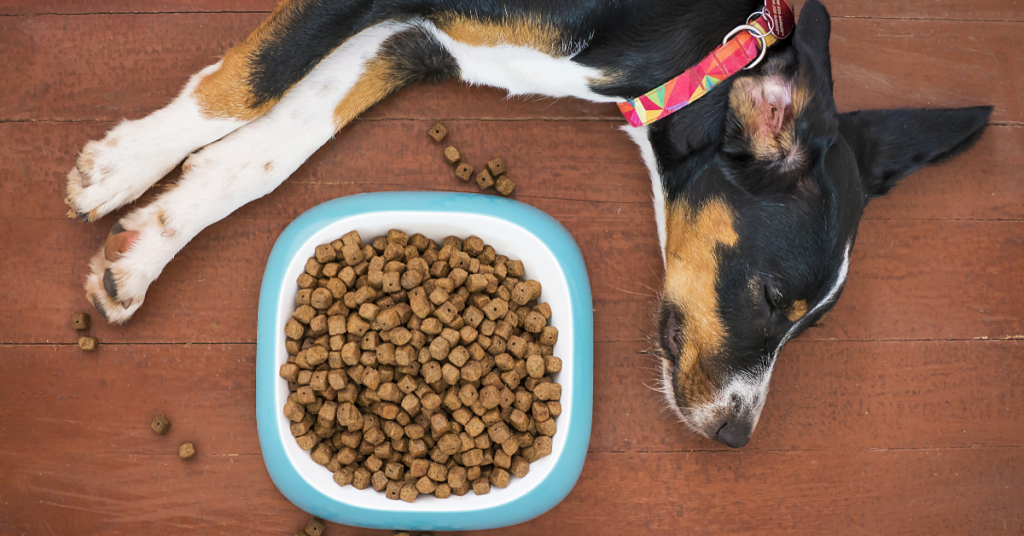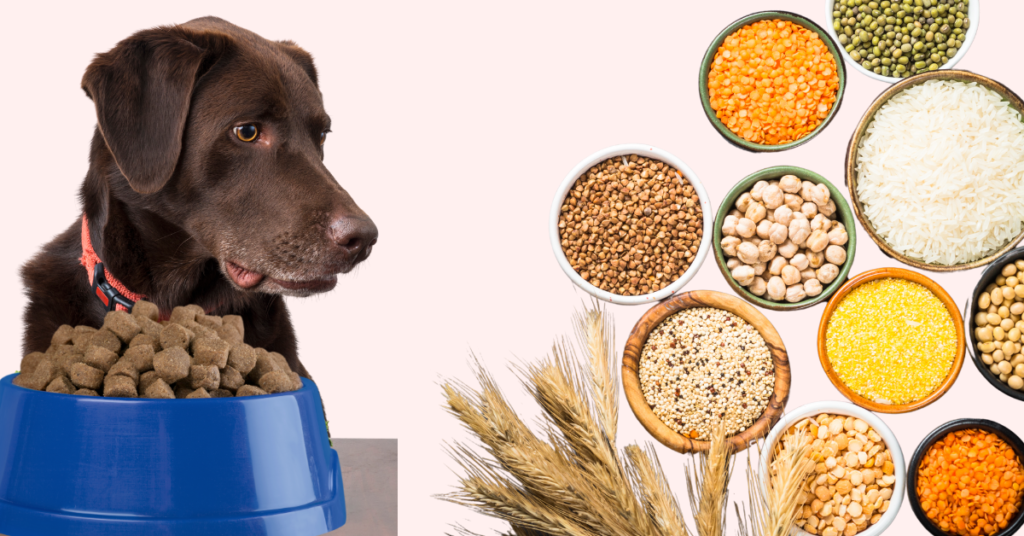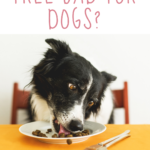For decades, dog food has contained grain. It’s been built largely on a foundation of grains like wheat, rice, and corn. The first dog biscuit was made largely out of wheat meals. These ingredients were inexpensive and provided energy for our dogs.
Recently, a revolution has hit the dog bowl—grain-free diets are all the rage. However, whispers of a potential link between these trendy meals and a serious heart condition have some dog owners wondering: Is grain free bad for dogs and are we giving our pups the building blocks they truly need?
Despite the growing popularity of grain-free dog food, some experts argue that the lack of traditional “bricks” compromises our dog’s digestive system and overall health. It’s important to closely examine the science behind the trend before feeding your dog grain-free food.
Let’s delve deeper into the debate surrounding grain-free diets, exploring the FDA’s investigation into a potential link to heart disease and the role of grains in a dog’s well-being.
Is Grain Free Bad for Dogs?
Sadly, we don’t have a definite answer to whether grain-free dog food is good for dogs! While grain-free diets have surged in popularity in recent years, concerns have emerged regarding a potential link to a serious heart condition in dogs.
Why is the FDA Investigating Grain-Free Dog Food?
The U.S. Food and Drug Administration (FDA) is currently investigating these reports, and while a clear cause-and-effect relationship hasn’t been established, understanding the ongoing research and potential risks is crucial for any dog owner considering a grain-free option.
Let’s take a quick look at the FDA investigation:
- The Investigation: In 2018, the FDA began investigating reports of canine dilated cardiomyopathy (DCM) in dogs fed grain-free diets. Unlike what many people think, these diets typically do not contain more meat than grain-inclusive diets. Instead, they often contain high legumes, lentils, and potatoes.
- Reported Cases: The FDA has received reports of over 1,300 dogs with DCM. Many of these dogs have been fed grain-free diets. It’s important to note that correlation doesn’t necessarily mean causation. Furthermore, getting an accurate number of affected dogs is hard, as these cases are likely underreported.
It definitely seems that grain-free dog food may be bad for some dogs. But we don’t know why some dogs may develop DCM on a grain-free diet while other dogs eat it for years without ill health effects.
What is Canine Heart Disease or Dilated Cardiomyopathy (DCM)?
Dilated cardiomyopathy (DCM) is a serious heart condition affecting dogs. It weakens and enlarges the heart muscle, specifically the left ventricle, which pumps oxygen-rich blood. This weakening compromises the heart’s ability to pump effectively, leading to problems.
Symptoms of DCM in dogs often include things like:
- Coughing
- Difficulty breathing
- Lethargy
- Weight gain due to fluid accumulation
- Fainting
- Collapse
There are some breeds that are prone to DCM. However, hereditary DCM is different from diet-influenced DCM. If your dog is genetically prone to DCM, treatment often involves slowing the progression and treating symptoms. However, dietary-linked DCM can often be treated with dietary changes and sometimes even reversed.
That said, dogs with a genetic predisposition to DCM may also be more likely to get dietary-linked DCM. Here are dog breeds that are more susceptible:
- Doberman Pinscher
- Great Dane
- Boxer
- Irish Wolfhound
- Saint Bernard
- Cocker Spaniel (genetic predisposition for taurine deficiency)

What is Grain-Free Dog Food?
Grain-free dog food is exactly what the name suggests – dog food without wheat, rice, corn, and barley. These traditional staples are not usually replaced with meat, as you might expect. Instead, they are often replaced with alternative carbohydrates, like peas, lentils, potatoes, and sweet potatoes.
Of course, some dog foods do include added protein, not just extra potatoes. It’s important to check the nutrition facts, though.
The rise of grain-free dog food can be attributed to several factors:
- Grain Allergies: A small percentage of dogs may have real grain allergies or sensitivities. These allergies are very uncommon, though. When dogs do have allergies, the best option is typically to avoid grains by purchasing grain-free dog food.
- Alternative Carbohydrate Sources: Grains are often the primary source of carbohydrates in dog food. However, some recipes include other sources of carbohydrates. Sometimes, this is just because of preference – not because the company is worried about grain allergies.
Often, these grains are replaced by a substitute carbohydrate. These include several different options:
- Legumes: Legumes like beans and peas are a great source of plant-based protein. They’re often used to increase the protein content of a dog food without adding more meat (which is often expensive). However, some studies suggest that excessive amounts of legumes may interfere with nutrient absorption due to the presence of lectins.
- Potatoes: These root vegetables provide lots of carbohydrates. They’re also full of essential vitamins and minerals! Unlike legumes, research on potatoes in dog food has been largely positive. It can improve the digestibility of nutrients and is often more palatable than corn.
What’s the Argument for Grain-Free Dog Food?
While grain-free dog food hasn’t been heavily studied, those who feed it to their dog often list several potential benefits:
- Address allergies or sensitivities: Some dogs are allergic to grains. According to some sources, around 10% of all dogs are allergic to grain products. These dogs often benefit best when grains are avoided in their diet. Even if a dog isn’t truly allergic, sensitivities can cause itching and digestive upset when the dog consumes too much wheat, corn, or another grain.
- More natural diet: Dogs are descended from wolves, so many dog owners believe that a meat-based diet is more in line with what dogs need. While protein is necessary for dogs, they have evolved to eat grains. Furthermore, most grain-free dog foods do not actually contain more meat. If you’re feeding your dog grain-free food for this reason, make sure the recipe actually contains added meat.
- Improved digestion: Some grain-free dog foods are made with high-fiber veggies, like potatoes and peas. These can aid in some dogs’ digestion.
That said, many of these improvements are not studied. High-fiber dog food can help with digestion, but not all grain-free foods are high in fiber. Furthermore, there is no study that has found a high-protein diet good for most dogs. In fact, a high-protein diet can have detrimental effects. Dogs do need carbohydrates, just like humans.
Can Grain Substitutes Cause Health Issues in Dogs?
As I’ve noted, there is some concern that grain-free diets may cause health issues in dogs. This is partially because of the inclusion of legumes as a substitute for grains. A lack of grains may not necessarily be bad, but the common addition of legumes may be.
The FDA is investigating a potential link between grain-free foods and DCM, as discussed above. This investigation seems connected to the ingredients commonly found in grain-free foods, like lentils and potatoes.
The concern is that these substitutes may interfere with taurine absorption, a necessary nutrient for your dog’s heart.
Of course, this connection has not been proven yet. Other factors are at play, but more research is necessary to determine what ingredients are harmful and how much they cause harm. Therefore, there haven’t been many practical applications provided for this information.
Vets often have mixed opinions on what to do, and grain-free dog foods are still freely sold.

What Does All This Mean?
All of this information can be overwhelming (and not very practical, to be honest). Grain-free food likely doesn’t have many of the benefits commonly associated with it. A high-protein diet can harm some dogs, and most grain-free foods don’t contain that much added meat, anyway.
It’s important to understand that a grain-free diet only means a grain-free diet. It doesn’t mean it’s higher in protein or more like what your dog would “naturally” eat. These proposed benefits just aren’t so.
The main benefit of grain-free dog foods is that they allow dogs with allergies to avoid their allergen. However, dogs are much more likely to be allergic to chicken or beef. Grain allergies are actually pretty rare. If your dog has an allergy, check what’s in their dog food. If it contains chicken or beef, consider switching to a food that doesn’t.
When determining the source of allergies, your best bet is typically to eliminate the most likely sources: chicken and beef.
Of course, contacting your vet is also highly recommended. Determining exactly what allergen is causing your dog’s problem can be difficult.
If your dog doesn’t have an allergy to grains, there are likely more drawbacks to grain-free foods than benefits. The FDA investigation is troublesome, though it’s unclear if anything will come from that.
I’m still concerned that certain grain substitutes, particularly peas, could cause heart-related issues, as this was never disproven. For that reason, I make sure that, when I pick up my dog’s food, it is the option that contains grain (there is a grain-free option).
Most dogs can digest grains perfectly fine!

Should You Avoid Grain-Free Dog Food?
That said, this doesn’t necessarily mean that you should avoid grain-free dog foods. A dog food isn’t necessarily bad just because it doesn’t contain grains.
There are many quality dog foods out there that don’t contain grains. Some high-protein dog foods may include tons of meat and be grain-free without any added peas, potatoes, or lentils. For an athletic dog, these may be very helpful in improving muscle mass (though the average dog likely doesn’t need them).
Once again, vets have a range of different opinions on the matter. Personally, I look at the ingredient list as a whole. If the first five ingredients include several instances of peas, potatoes, and other legumes, it probably isn’t the best option for your pooch – whether it is grain-free.
You should always watch for “ingredient splitting.” Simply put, this practice is when a company breaks up one ingredient into several smaller ones, allowing it to appear further down the list. A very common instance is when peas are broken into “pea protein,” “pea starch,” and “pea fiber.” That’s all of a pea.
However, because ingredient lists are organized by weight, all of these ingredients would appear lower on the list. If they were all counted as one ingredient and listed as “peas,” it would be clear that much of the dog food was peas.
This is something for you to look out for.
3 Alternatives to Grain-Free Dog Foods
After reading this article, it’s completely understandable if you don’t want to feed your dog a grain-free dog food. However, I still recommend not just grabbing whatever grain-inclusive dog food is on the shelf. If you’re looking to feed your dog only the best food, here’s what I would recommend (in my non-professional opinion!):
1. Grain-Inclusive Dog Food with Whole Grains
Grain-inclusive dog foods work well for the vast majority of dogs. However, I recommend selecting a dog food with whole grains. Dogs can digest grains, as I’ve discussed extensively. Whole grains include added fiber, protein, and nutrients, though. Brown rice, oatmeal, and barley are all very suitable options.
Just like whole grains are better for humans, they’re also better for dogs!
Of course, I still don’t recommend choosing a food that is mostly grains. Instead, look for whole grains as the primary source of carbohydrates, but the first ingredient should be meat. Think of grains as the “side” and meat as the primary source of calories. Choose a dog food that matches this idea.
2. Limited Ingredient Diets
I recommend a limited-ingredient diet for dogs with food allergies. Grain-free food is often not enough. You want food with very few ingredients so that it’s easier to ensure that your dog is not allergic to anything.
Limited-ingredient pet foods contain very few ingredients. Some have as few as two or three (besides the vitamin mix). However, some diets will be labeled “limited ingredients” and still contain five or more ingredients.
Some of these diets are grain-inclusive, but some others are grain-free. A grain-inclusive option is fine if your dog isn’t allergic to grains (like most dogs with allergies). However, grain-free food is your best bet if your dog is allergic to grains!
3. Veterinary Diet
You may need to consider a veterinary diet if your dog has severe allergies. These diets are designed for dogs with food allergies or other underlying health concerns. If you speak to your vet, there is a chance they will recommend a veterinary diet.
These diets often require a prescription, though some can be purchased online or at your local pet store. They can be exceptionally expensive, and most dogs with allergies won’t need them. Therefore, I only recommend them as a last resort. If your dog is allergic to practically everything, one of these diets may be necessary.
Navigating the Grain Debate for Your Dog’s Health
The question of grain-free dog food and its potential impact on canine health remains complex. While the FDA investigation continues, the lack of conclusive evidence necessitates a cautious approach.
I don’t recommend avoiding grain-inclusive foods unless your dog is allergic to grains. You don’t necessarily have to feed your dog grain, either. Just be sure to check the ingredient list and look for high-quality ingredients. I wouldn’t recommend it if a dog food recipe appears to be mostly peas!
If you want a high-meat diet, look for foods with several meat ingredients in the first five ingredients. Wet dog food also tends to have more meat, as it doesn’t need as much starch to hold it together. However, wet food can also be more expensive than dry dog food.
I personally feed my dog Farmina Ancestral Grain because it uses 90% animal protein (as opposed to plant protein), whole grains and works within my budget.



